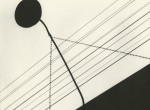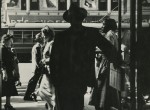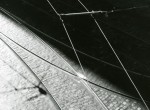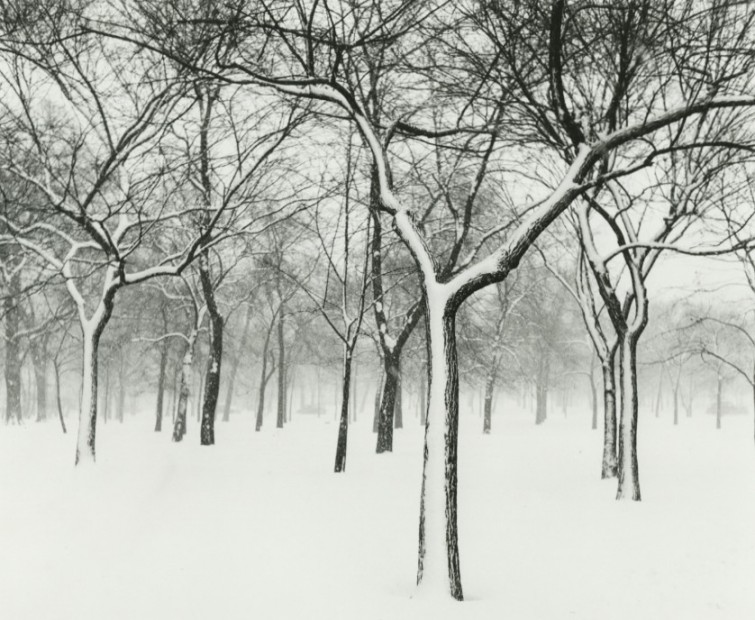 Lincoln Park, Chicago, 1948Gelatin silver photograph on mount. 1940s-50s print. Signed, titled and dated in ink my artist on mount verso. Annotated 'c1565' on verso. [Estate no.137-3]Contact For Pricing & Availability
Lincoln Park, Chicago, 1948Gelatin silver photograph on mount. 1940s-50s print. Signed, titled and dated in ink my artist on mount verso. Annotated 'c1565' on verso. [Estate no.137-3]Contact For Pricing & Availability
16 X 20 inches Store Display, Chicago, 1947-48Gelatin silver photograph on mount. 1940s-50s print. TItled, dated and annotate '1017-24' in pencil by artist on print verso. [Estate no.1370-4]Contact For Pricing & Availability
Store Display, Chicago, 1947-48Gelatin silver photograph on mount. 1940s-50s print. TItled, dated and annotate '1017-24' in pencil by artist on print verso. [Estate no.1370-4]Contact For Pricing & Availability
10 11/16 X 10 7/16 inches Fire Escape, Chicago, 1947-48Gelatin silver photograph on mount. 1940s-50s print. Artist's Copyright Phot. No. stamp on verso. [Estate no.1171-1]Contact For Pricing & Availability
Fire Escape, Chicago, 1947-48Gelatin silver photograph on mount. 1940s-50s print. Artist's Copyright Phot. No. stamp on verso. [Estate no.1171-1]Contact For Pricing & Availability
13 3/4 X 10 7/8 inches Fire Escape, Chicago, 1947-48Gelatin silver photograph on mount. 1940s-50s print. Annotated '1018/ 8' in ink by artist on print verso. Artist's Copyright Phot. No. stamp on verso. [Estate no.1172-1]Contact For Pricing & Availability
Fire Escape, Chicago, 1947-48Gelatin silver photograph on mount. 1940s-50s print. Annotated '1018/ 8' in ink by artist on print verso. Artist's Copyright Phot. No. stamp on verso. [Estate no.1172-1]Contact For Pricing & Availability
11 3/8 X 10 15/16 inches Chicago, 1947-48Gelatin silver photograph on mount. 1940s-50s print. Provenance: Ferenc Berko Estate. [Estate no.2894-1]Contact For Pricing & Availability
Chicago, 1947-48Gelatin silver photograph on mount. 1940s-50s print. Provenance: Ferenc Berko Estate. [Estate no.2894-1]Contact For Pricing & Availability
10 X 5 1/8 inches Untitled, c.1949Gelatin silver photograph. 1940s-50s print. Annotated '1017-14.' [Estate no.1346-1]Contact For Pricing & Availability
Untitled, c.1949Gelatin silver photograph. 1940s-50s print. Annotated '1017-14.' [Estate no.1346-1]Contact For Pricing & Availability
9 9/16 X 7 3/4 inches Queen Mary, c.1949Gelatin silver photograph. 1940s-50s print. Annotated '1451-9.' [Estate no.1347-1]Contact For Pricing & Availability
Queen Mary, c.1949Gelatin silver photograph. 1940s-50s print. Annotated '1451-9.' [Estate no.1347-1]Contact For Pricing & Availability
6 3/4 X 9 5/8 inches Chicago, 1948Gelatin silver photograph. 1940s- 50s print. Titled, dated and annotated '2/1024/24' in pencil and ink by artist on print verso. Artist's Copyright Phot. No. stamp on verso. Typed caption label affixed to print margin recto.[Estate no.1393-4]Contact For Pricing & Availability
Chicago, 1948Gelatin silver photograph. 1940s- 50s print. Titled, dated and annotated '2/1024/24' in pencil and ink by artist on print verso. Artist's Copyright Phot. No. stamp on verso. Typed caption label affixed to print margin recto.[Estate no.1393-4]Contact For Pricing & Availability
9 9/16 X 7 7/16 inches Chicago, 1947-48Gelatin silver photograph. 1940s-50s print. Annotated '1393-12' in pencil by artist on print verso. Artist's Phot. Nr. stamp on verso. [Estate no.2800- 1]Contact For Pricing & Availability
Chicago, 1947-48Gelatin silver photograph. 1940s-50s print. Annotated '1393-12' in pencil by artist on print verso. Artist's Phot. Nr. stamp on verso. [Estate no.2800- 1]Contact For Pricing & Availability
9 11/16 X 7 7/8 inches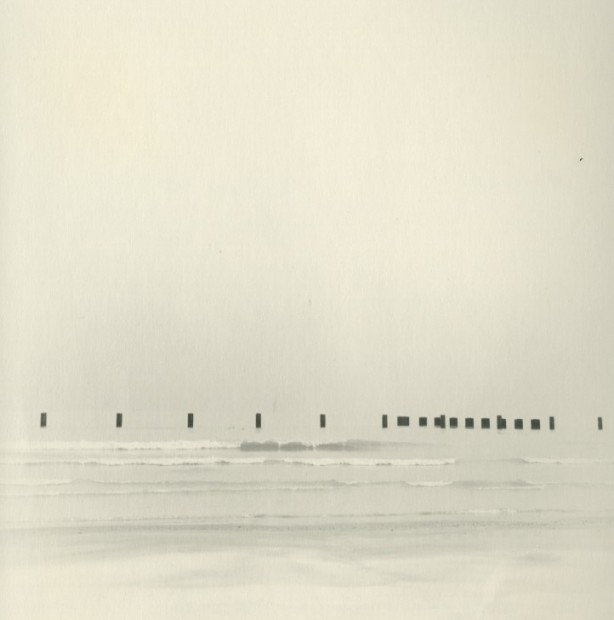 Chicago, Lake Michigan, 1947-48Gelatin silver photograph. 1940s print. Annotated '1319-11' in pencil by artist on print verso. [Estate no.51-3]Contact For Pricing & Availability
Chicago, Lake Michigan, 1947-48Gelatin silver photograph. 1940s print. Annotated '1319-11' in pencil by artist on print verso. [Estate no.51-3]Contact For Pricing & Availability
7 13/16 X 7 3/4 inches Tram Lines, New York, Oct. 1949Gelatin silver photograph. 1950s-60s print. Dated and annotated '1219- 9' in pencil by artist on print verso. [Estate no.81-7]Contact For Pricing & Availability
Tram Lines, New York, Oct. 1949Gelatin silver photograph. 1950s-60s print. Dated and annotated '1219- 9' in pencil by artist on print verso. [Estate no.81-7]Contact For Pricing & Availability
9 5/8 X 7 7/8 inches Billboard Lights, New York, 1950Gelatin silver photograph. 1950s-60s print. Various annotations in pencil by artist on print verso. [Estate no.567-10]Contact For Pricing & Availability
Billboard Lights, New York, 1950Gelatin silver photograph. 1950s-60s print. Various annotations in pencil by artist on print verso. [Estate no.567-10]Contact For Pricing & Availability
8 3/8 X 6 1/4 inches Chicago, Fahrrad-Geschaft, 1948Gelatin silver photograph. 1940s- 50s print. TItled, dated and annotated '1046-19' in pencil by artist on print verso. Artist's Aspen credit stamp on verso. [Estate no.2949-1]Contact For Pricing & Availability
Chicago, Fahrrad-Geschaft, 1948Gelatin silver photograph. 1940s- 50s print. TItled, dated and annotated '1046-19' in pencil by artist on print verso. Artist's Aspen credit stamp on verso. [Estate no.2949-1]Contact For Pricing & Availability
Ferenc Berko
Ferenc Berko (1916-2000) was born in Nagyvárad, Hungary. After his parents passed away while Berko was still young, he was raised by family friends in Berlin, Germany. His adoptive parents encouraged the boy’s creative energies and gave him his first camera. The family spent time with artists and teachers of the Bauhaus School, among them László Moholy-Nagy, Walter Gropius, and Marcel Breuer, who inspired Berko’s passion for modern art and photography. Moholy-Nagy especially became a friend and mentor. In the 1930s, Berko was sent to live in London and study philosophy. While there he also became immersed in photojournalistic as well as fine art photography and short documentary films. He then encountered another major figure in photography, Emile Hoppe, who also served as mentor. After his studies, Berko moved to Paris where he worked with his new wife, Mirte (whom he married in 1937) on a series of photographic studies of the nude. In 1937, he traveled to Hungary to document the Jews of Budapest, but by 1938, the growing power of Nazism compelled him to leave. In 1938 Berko moved to Bombay, India and held various positions as a documentary filmmaker, often working closely with the British as well as the Indians. Here he spent considerable time in photographic experimentation.
In 1947, Berko who had become British by naturalization, had his first one-man show; this at the Victoria and Albert Museum. He also left India that year to move to the United States, where he arrived in Chicago in answer to a job offer from his old friend, Moholy-Nagy. Moholy had just died of leukemia but Berko stayed and taught photography and filmmaking at the Institute of Design 1947-48. While there he made work centering on the abstraction offered by urban design. He was also doing work for publications such as Paris-Match, Réalitiés and Popular Photography. In 1948, Berko was invited to visit Aspen, Colorado by industrialist and philanthropist (and guiding force behind the Institute of Design) Walter Paepcke, to document the post-war transition and development of the town. Paepcke also hoped his friend would want to stay. However, Berko and his family returned to London hoping to reestablish themselves,but were quick to return to Aspen after seeing postwar living conditions. Once settled, Berko continued to work, in photography and filmmaking, using the rapidly evolving community as a base for his extensive world travel. He exhibited his photographs in numerous publications and exhibitions, until his death in March 2000. Berko’s photographs are in the collections of the Museum of Modern Art in New York, The Metropolitan Museum of Art, the San Francisco Museum of Art, the Gernsheim Collection, the Center for Creative Photography, the Ludwig Museum, Cologne among others. In 1995, Ferenc Berko: 60 Years of Photography-The Discovering Eye, was published by Edition Stemmle. In 1995 Berko: Photographs was published by Graphis.
Exhibitions
ArrayNo Upcoming Exhibitions
Publications
No Artist Publications

